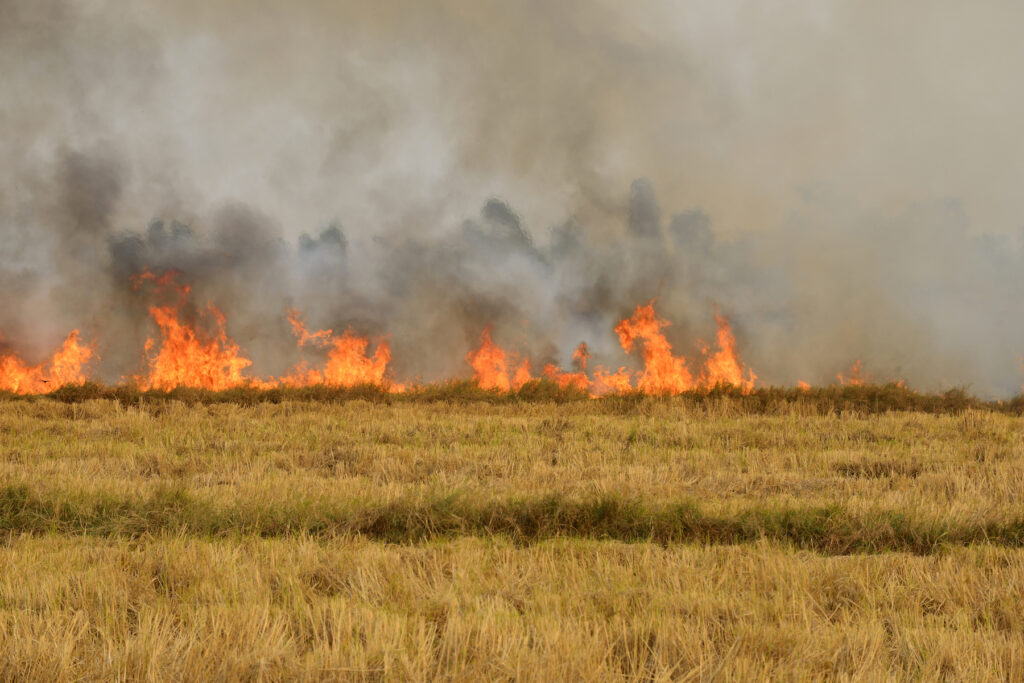Upgrade fire precautions ahead of harvest, insurer warns
26th May 2023
The cost of agricultural vehicle and machinery fires was up by 35% in 2022, according to NFU Mutual.

Rural insurer NFU Mutual is issuing new fire prevention advice, including extra cleaning and maintenance, and combine fire suppression systems, after a blazing hot summer last year.
Combine fires reported to the insurer in 2022 cost over £7million, up from £2.9m the previous year, as long periods of dry weather combined with temperatures reaching more than 40ºC sparked ideal fire conditions. The overall cost of agricultural vehicle and machinery fires increased by 35% to £28.3million, the latest figures show.
Many farmers increased fire prevention measures, including fitting fire suppression systems to their combines, cleaning combines more regularly and avoiding harvesting in very hot weather.
On some farms, combine fires spread into fields, engulfing hectares of growing crops and putting nearby properties at risk. Farmers’ efforts to quickly use tractors to make fire breaks prevented some fires spreading.
However, these emergency measures can endanger lives, with at least three incidents where fast-spreading crop fires engulfed tractors cutting fire breaks, leaving drivers fleeing for their lives.
Following last year’s extreme harvesting weather conditions, NFU Mutual is recommending that farmers increase regular cleaning stops and consider a range of additional fire prevention measures to reduce fire risks in future very hot summers.
Following a testing programme on combine harvesters, NFU Mutual recommends P-Mark SPCR199 accredited fire suppression systems. The systems automatically trigger extinguishers if a small fire is detected in the machine. The insurer now offers premium discounts for farmers fitting recommended systems.
Craig Codling from NFU Mutual’s Agricultural Engineering Team said: “Last year’s very hot summer led to a large number of fires – despite farmers carrying out regular maintenance and chaff cleaning.
“To reduce fire risks in very hot, dry summers in the future we’ve worked with fire services and machinery manufacturers to issue new harvest fire prevention guidelines.
“Today’s combines are extremely large and complex, which means that a small fire caused by overheating or an electrical fault can very quickly turn into a blaze that engulfs the whole machine. There’s also a significant risk that the fire can spread into crops and then destroy other machinery and even nearby houses.
“The speed at which fire can spread through a dry crop is frightening. A number of farmers who tried to use their tractors and cultivation implements to cut a fire break to stop a crop blaze found this out when their machinery was engulfed by the flames and they had to run for their lives.
“Keeping people safe is always the first priority, and we urge farmers and their staff to only tackle a machinery fire while it is small and they can do so without putting themselves at risk.
“Combine fire suppressing systems are very good at putting out small fires safely and efficiently. We’ve tested modern ‘P Mark’ Rated suppressors and now recommend them to our policyholders.”
NFU Mutual harvest fire prevention guide:
- Regularly clean out dust and chaff from hot spots in combines and balers daily while in use and twice a day in very dry conditions
- Fit a fire suppression system that meets P-mark status to contain, extinguish and prevent fire
- Switch off engines and ensure moving parts have stopped before clearing blockages or carrying out maintenance
- Always stop to investigate hot-running engines or bearings
- Have a plan in place to raise alarms, check team safety and direct emergency services to the fire site
- Keep mobile phones on you at all times – not left in a tractor or pickup cab
- Make sure drivers are aware of the locations and heights of power lines and check that machinery will safely pass under wires
- Ensure there is a recently-serviced fire extinguisher on the combine
- Ensure the harvest team knows where the nearest water source is
- Use the what3words app to help direct emergency services to the site of fires
- Clean dust regularly from grain dryers – and ensure that all staff are fully trained and know what to do if fire breaks out
- Fully service harvesting machinery before starting work
- Keep cultivators on hand to put in fire breaks in the event of a crop fire
- Keep water bowsers filled and near harvesting operations available to tackle spot fires.
- If possible, harvest crops so that the wind drives any fire in the direction of the already cut crop
- Take care when using air compressors to clean chaff to avoid the risk of from injecting air into the skin and causing bubbles in the blood stream by wearing PPE and reducing air pressure below 30psi/2.1 bar
- Check the Fire Severity Index to help avoid harvesting in peak temperatures www.metoffice.gov.uk/public/weather/fire-severity-index
